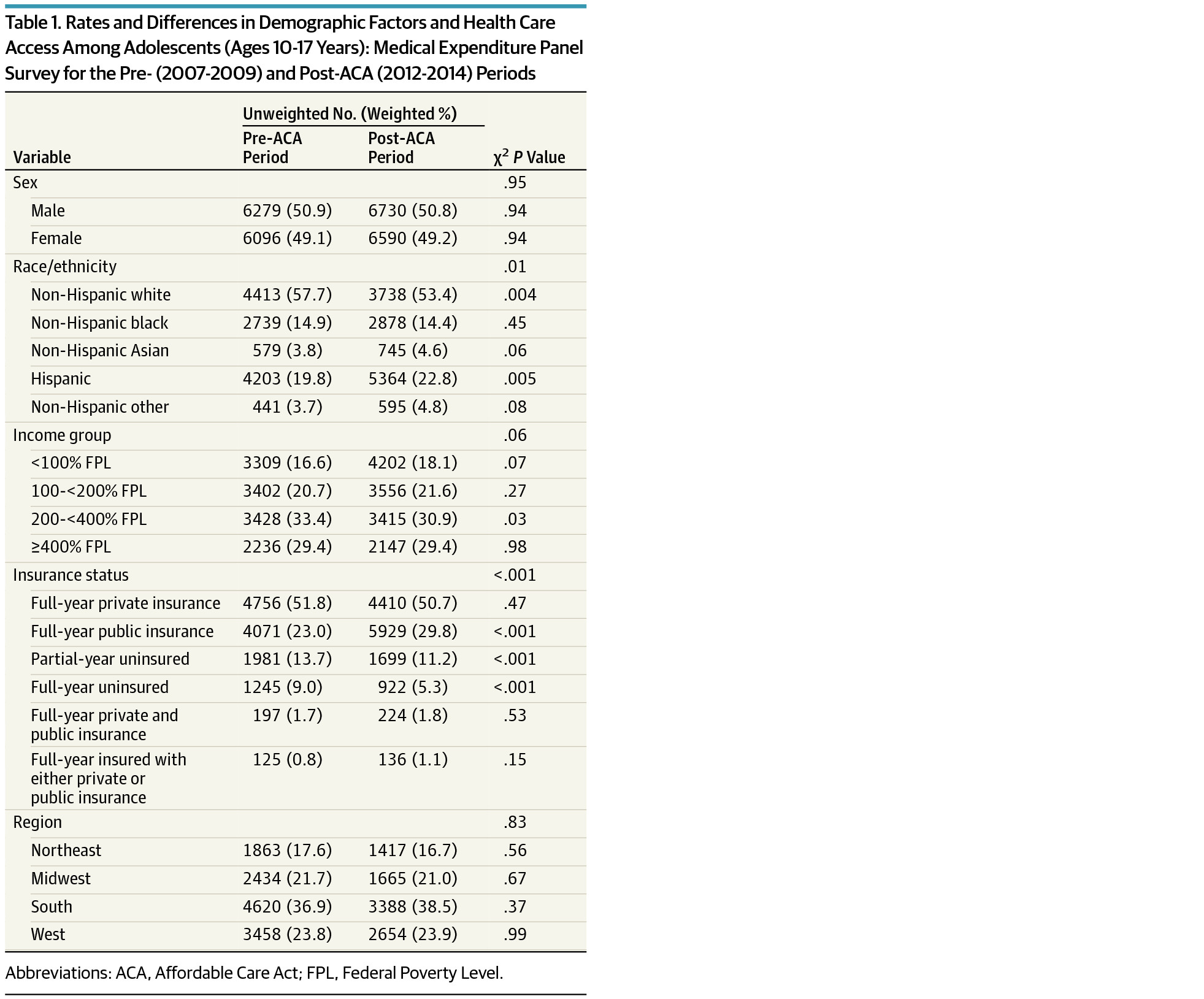当前位置:
X-MOL 学术
›
JAMA Pediatr.
›
论文详情
Our official English website, www.x-mol.net, welcomes your
feedback! (Note: you will need to create a separate account there.)
Association Between Adolescent Preventive Care and the Role of the Affordable Care Act
JAMA Pediatrics ( IF 24.7 ) Pub Date : 2018-01-01 , DOI: 10.1001/jamapediatrics.2017.3140 Sally H Adams 1 , M Jane Park 1 , Lauren Twietmeyer 1 , Claire D Brindis 1, 2 , Charles E Irwin 1
JAMA Pediatrics ( IF 24.7 ) Pub Date : 2018-01-01 , DOI: 10.1001/jamapediatrics.2017.3140 Sally H Adams 1 , M Jane Park 1 , Lauren Twietmeyer 1 , Claire D Brindis 1, 2 , Charles E Irwin 1
Affiliation

|
Importance Despite decades of adolescent preventive well visit and services promotion (Guidelines for Adolescent Preventive Services and Bright Futures), rates are below recommended levels and little is known of the effect of the Patient Protection and Affordable Care Act (ACA) implementation on these care rates. Objectives To use Medical Expenditure Panel Survey data to determine (1) whether adolescent well visit rates increased from the pre-ACA period to post-ACA period, and (2) whether caregivers’ reports of past-year preventive services delivery increased from the pre- to post-ACA period among adolescents with any past-year health care visit. Design, Setting, and Participants Secondary data analysis of 2007-2009 (before ACA implementation) and 2012-2014 (after ACA implementation) Medical Expenditure Panel Survey data on the differences in well visits and preventive services. Data were collected through computer-assisted personal interviews of caregivers of a nationally representative sample of a noninstitutionalized US population (n = 25 695 10- to 17-year-old adolescents). Main Outcomes and Measures For objective 1, pre- to post-ACA period differences in past-year well visits: (1) stratified bivariable logistic regressions identifying subgroup rate differences and (2) multivariable analyses controlling for demographic factors. For objective 2, pre- to post-ACA period differences in caregiver reports of preventive services receipt, including time alone with clinician: (1) bivariable (year differences) and (2) multivariable logistic regressions controlling for demographic variables. Results A total of 6279 (50.9%) and 6730 (50.8%) participating adolescents in the pre- and post-ACA period data were male, respectively. Under objective 1, we found that well-visit rates increased from 41% to 48% post-ACA implementation (odds ratio, 1.3; 95% CI, 1.2-1.5); minority and low-income groups had the greatest increases. Under objective 2, we found that among those with any past-year visit, most preventive services rates (8 of 9) increased post-ACA implementation (range, 2%-9%, absolute), with little or no change when controlling for demographic variables. Time alone with clinicians increased 1%, significant only when covariates were controlled (adjusted odds ratio, 1.2; 95% CI, 1.0-1.3). Conclusions and Relevance Despite modest to moderate increases, with greatest gains for underserved youth, adolescent preventive care rates remain low, highlighting the need for increased efforts to bring adolescents into well care and improve clinician delivery of preventive care within their practices.
更新日期:2018-01-01











































 京公网安备 11010802027423号
京公网安备 11010802027423号